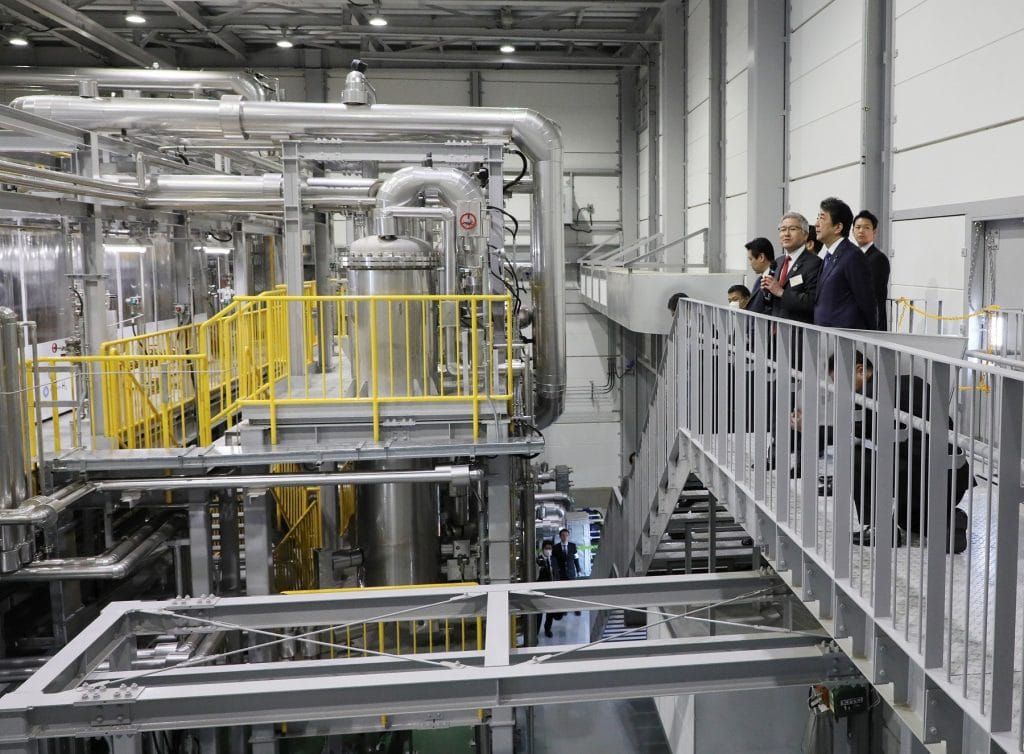Whether green, blue, or turquoise, hydrogen needs to be clean and cheap
By Eric McFarland | January 21, 2022
 Former Japanese Prime Minister Shinzo Abe tours the Fukushima Hydrogen Energy Research Field (Photo by the Ministry of Economy, Trade and Industry/Prime Minister’s Office)
Former Japanese Prime Minister Shinzo Abe tours the Fukushima Hydrogen Energy Research Field (Photo by the Ministry of Economy, Trade and Industry/Prime Minister’s Office)
Low-cost fossil fuel resources are finite. Someday it will simply not be possible to burn oil, natural gas, and coal for the affordable heat, electricity, and motive power humans need to power their prosperous societies. When “someday” will occur is debatable, but the environmental and economic costs of delaying the inevitable transition away from fossil fuels is likely greater the longer we wait.
Redesigning and rebuilding our global energy infrastructure is a monumental task with wide-ranging cost estimates, but most economists estimate that continuing to burn fossil fuels will be costlier than phasing out their use sooner rather than later. However, few countries are making significant progress in replacing fossil fuels and, without global participation, emissions reduction efforts by a minority will be ineffective. A meaningful international regulatory framework to guide the transition is required to provide the necessary economic incentives and drive much-needed innovation, like in the chemical fuel sector.
There is little doubt that increasing use of electricity produced from nuclear power and renewable hydroelectric, wind, and solar power systems will be a major component of our future sustainable energy systems. However, large-scale use of chemical fuels will also likely be needed, and one promising candidate is molecular hydrogen.
Clean hydrogen. The notion of a “hydrogen economy” has gone in and out of fashion within governments since the 1970s. The Energy Policy Act of 1992 included a five-year research and development program on “Renewable Hydrogen Energy,” and various roadmaps have been put forth by different administrations to enable widespread use of hydrogen. In 2003 President Bush proposed $1.2 billion in funding for hydrogen fuel development. The recent passage of the bipartisan infrastructure bill sets aside $8 billion to develop four regional clean hydrogen infrastructure hubs as well as other hydrogen-related programs. Combined, the bill’s various authorizations amount to almost $10 billion to promote hydrogen as a fuel and to foster means for decreasing the cost and the emissions associated with its production. The bill defines clean hydrogen as hydrogen produced with less than 2 kilograms of carbon dioxide per kilogram of hydrogen at the site of production. How to most wisely spend the taxpayer’s money for the maximum benefit to society is the $10 billion dollar question.
Hydrogen makes up the majority of atoms in the universe. On Earth, it is primarily found deficient in electrons, oxidized with a positive electrical charge in water and in hydrocarbon-containing matter. These are the only abundant resources from which molecular hydrogen for fuels can be made, and this requires adding energy to reduce the oxidized hydrogen atoms to produce molecular hydrogen, a colorless gas.
Grey hydrogen. Current global production of hydrogen is approximately 75 million tons per year, which is primarily used to produce critical chemicals, including ammonia for fertilizer. Most of that hydrogen comes from reforming fossil hydrocarbons with water, yielding approximately 10 kilograms of carbon dioxide per kilogram of hydrogen. This “grey hydrogen” or “black hydrogen,” as it is known, when produced from low-cost gas or coal, can be delivered at a price of approximately $1/kilogram (if there is no economic penalty for the associated carbon dioxide emissions).
The price of $1/kilogram of hydrogen works out to an energy price of approximately $8/gigajoule or $0.03/kilowatt-hour; by comparison gasoline at $3/gallon is $25/gigajoule or $0.09/kilowatt-hour. But while grey or black hydrogen may be relatively cheap, as a fuel source gas is even cheaper and we would be better off just burning it in the first place in terms of carbon emissions.
If much greater quantities of hydrogen could be produced from low-emissions processes at a price of under $2-3/kilogram, it could be burned or used in fuel cells to produce the heat, electricity, and power previously generated from fossil fuels. Hydrogen might also be used instead of coal to produce iron, which today accounts for five percent of global carbon dioxide emissions. Aviation is difficult to electrify, and most sustainable aviation fuel production pathways require hydrogen. The availability of more sustainable, low-cost hydrogen would likely enable other applications throughout industry.
For economic sustainability, energy and fuel must have low costs of production. The hardships of increasing fuel prices fall most severely on the poor. Widespread use of hydrogen in vehicles will be the most challenging area to demonstrate clear cost-effectiveness. Today, hydrogen fuel cell-powered vehicles are available at reasonable costs. They fill-up quickly at one of a limited number of filling stations, and provide transportation as safe and pleasant as any vehicle available. Unfortunately, the transportation and handling of relatively small quantities of mostly gray hydrogen for these limited retail stations is expensive, and by the time hydrogen is transported to a fueling station as a very high-pressure gas, the price at the pump is over $15/kilogram. Hydrogen as a vehicle fuel is currently inconvenient to find, carbon dioxide intensive to produce, and expensive.
Fortunately, there are several pathways to produce lower-cost hydrogen with significantly lower carbon emissions and to make it more readily available to consumers.
Green hydrogen. Large quantities of molecular hydrogen can be produced from water using either electricity or heat. Electrochemical decomposition of water into hydrogen and oxygen has been practiced commercially since the late 1800s, and despite the long history of innovation, in practice, more than 50 kilowatt-hours are required to produce a kilogram of hydrogen. When the hydrogen produced from water is used for heat, electricity, or power, significantly less energy is recovered than was used to produce it in the first place. If low-cost electricity or heat is available from emissions-free sources—solar or wind, for example—in principle the hydrogen produced from water can be free of emissions, hence the designation, “green hydrogen.”
Large-scale facilities for producing hydrogen using electricity have been constructed and more are planned; however, there are limited amounts of emissions-free electricity available and thus most of these facilities are not yet green. The cost of the green hydrogen produced depends greatly upon the price of the emissions-free electricity, with estimates ranging from $5 to $7/kilogram.
Turquoise hydrogen. To produce hydrogen from fossil fuels requires much less energy than from water. After all, fossil fuels come from biomass produced by natural photosynthetic processes that use solar energy to transform carbon dioxide and water into hydrocarbons. That solar energy input is stored in the hydrocarbon molecules. Because nature already did half the work at no cost, decomposing methane into solid carbon and two hydrogen molecules requires less than approximately 6 kilowatt-hours per kilogram of hydrogen, or approximately one-seventh of the energy required to produce hydrogen from water.
The decomposition process of methane in natural gas or other fossil resources to produce hydrogen and solid carbon is called pyrolysis; the hydrogen produced has been labeled “turquoise hydrogen.” The process occurs without any oxygen-containing molecules and thus no carbon dioxide is formed. The solid carbon co-product resembles charcoal and can be safely and permanently stored by, for example, filling in abandoned coal mines.
If large quantities of low-cost electricity or heat from carbon dioxide-free sources become widely available, it could be used for pyrolysis, making it also, in principle, an emissions-free source of hydrogen. While low-cost natural gas is available, turquoise hydrogen can be much less expensive than green hydrogen (i.e., hydrogen produced by splitting water). There are no dedicated turquoise hydrogen commercial facilities currently up and running, but many are under development. The projected price of turquoise hydrogen is estimated to be approximately $2/kilogram, depending on the price of natural gas.
Blue hydrogen. Grey hydrogen obtained by reforming is associated with significant emissions both from the heat required to produce it (approximately 8 kilowatt-hours per kilogram of hydrogen) and from the chemical reaction of oxygen in water with the hydrocarbon. Half the hydrogen produced comes from the water and the other half from the hydrocarbon. The heat could be provided by the same emission-free sources as used by green hydrogen, but the carbon dioxide produced in the chemical reaction is unavoidable and must not be emitted.
The chemical industry has developed and tested processes to capture the carbon dioxide produced from the process and sequester it underground in what appear to be stable long term geological formations. When coupled with carbon dioxide capture and sequestration, hydrogen produced by reforming processes is called, “blue hydrogen.” Today, there are a limited number of sites for sequestration and the added cost is expected to increase the price of blue hydrogen to $2-3/kilogram.
The barriers to clean hydrogen use are color blind. Producing clean hydrogen of any color at large enough scale to make a difference in our transition to a fossil-fuel free future has significant challenges. Today, nobody can deliver affordable clean hydrogen.
The feedstocks for clean hydrogen must themselves be associated with acceptably low emissions. Providing large quantities of clean water for green hydrogen can likely be managed at very low cost. However, in practice all processes relying on fossil hydrocarbons will have additional emissions of methane and other greenhouse gases associated with the production and transportation of the resources to commercial blue or turquoise hydrogen facilities.
Methane is likely responsible globally for approximately 16 percent of global warming and natural gas production is thought to be responsible for approximately 7 percent of methane emissions worldwide. A recent article has rightfully pointed out that if natural gas is used as a source of blue or turquoise hydrogen, production will increase significantly, and, if current practices continue unchanged, the fugitive emissions will also increase. Current practices however, need not continue and can be changed and improved significantly.
A recent study found that full deployment by 2030 of available mitigation measures to reduce methane emissions can slow the rate of global warming over the next few decades by more than 25 percent, and that greater reductions were possible with technically feasible approaches. It is unknown how much the costs of minimizing these emissions will add to the cost of natural gas, and thus to blue or turquoise hydrogen, which depend strongly on the cost of the gas. It will be up to the producers to demonstrate this critical challenge can be met and how much it will add to the hydrogen cost.
If the barriers to acquiring emission-free hydrogen feedstocks are overcome, another challenge will remain: providing clean energy for producing the hydrogen. Today, there is very little dispatchable, low-cost, emissions-free electricity or heat. Blue and turquoise hydrogen use significantly less energy per kilogram of hydrogen produced than green hydrogen, and in fact a fraction of the hydrogen produced from blue or turquoise hydrogen processes could be used to provide their process energy guaranteeing the production to be carbon dioxide free. Green hydrogen processes produce less energy in their hydrogen product than is used to make it and thus depend entirely on the availability of very low-cost, low-emissions electric power. Until a significant expansion of renewable power occurs along with low-cost means for electricity storage, the hydrogen produced using electricity will have the associated greenhouse gas emissions of the electricity used to produce it.
Today, no color of clean hydrogen is widely available at scale, and the pathways to commercial realization claimed by their respective proponents are unproven. Green hydrogen requires massive quantities of very low-cost, emissions-free electricity which does not exist; blue hydrogen requires demonstration of low-cost separation and long-term sequestration technology which is unproven; turquoise hydrogen requires the demonstration of large-scale processes which today do not exist. Both blue and turquoise hydrogen require access to large quantities of low-cost, low-emissions natural gas which is not available today.
Although often ignored, all of the above clean hydrogen processes would also require reduction in the required capital investment for large-scale commercial facilities. The capital costs of all green hydrogen projects announced or completed are very high and would add over $1/kilogram to the cost of hydrogen produced. The capital cost for the facilities and storage locations required for capturing and storing carbon dioxide for blue hydrogen strongly depend on location; in some locations such as Japan it is not thought possible to deploy blue hydrogen at all. No large turquoise hydrogen facilities have been built and the capital costs are unknown; however, estimated costs are expected to be similar to blue hydrogen.
Thinking ahead. There is little doubt that in the distant future, when fossil resources are too scarce to be used for fuel, hydrogen will be produced sustainably from water, using heat or electricity supplied by nuclear, hydroelectric, wind, or solar power generation facilities. The most cost-effective way to start making the transition and building the enormous infrastructure required for deployment of hydrogen as a low-cost fuel is to begin by using the cheapest clean hydrogen available, whatever its color.
While fossil fuels remain abundant at low cost, without a penalty for greenhouse gas emissions, no clean hydrogen technology can compete economically with conventional gray hydrogen processes. Only if most societies choose to address the risks of greenhouse gases and the certainty of the eventual exhaustion of low-cost fossil resources while we still have choices and time—and, governments of most nations act to create meaningful economic incentives and disincentives to make the transition—only then will large-scale deployment of clean hydrogen technologies occur in the near term. Innovation incentivized by regulations and economic rewards is how the quality of the air and water in most of our cities was dramatically improved.
When industry’s products are charged for externalities such as greenhouse gas emissions, better ways of doing things are invented and adopted.
If technologies making use of fossil resources can be demonstrated to produce truly clean hydrogen at the lowest cost there is no reason not to leverage these resources while they remain abundant for the benefit of all societies. Today, there are few disincentives that would push natural gas producers to change current practice, just as there are few meaningful financial disincentives for nations burning coal to discontinue use of this low-cost, high-emissions fuel, or for mining companies providing the materials for electric vehicles to provide increased environmental protections to the land and water around their mining sites. All real progress in transitioning away from greenhouse gas-emitting processes and other unsustainable practices will rely on innovation responding to governments imposing economic costs to continuing business as usual.
The lack of a consistent global price on emissions today is why significant progress has not occurred.
Provided all emissions from all technologies are appropriately and uniformly taxed, innovation and the market, and not the government, is best equipped to decide which processes for producing emissions-free hydrogen provide the greatest value to consumers and make the transition to a fossil-fuel free future the least economically disruptive. The $10 billion dollars for promoting hydrogen as a fuel should be color blind and demand only that all efforts be focused on demonstrating the delivery of clean hydrogen at the lowest cost.
Together, we make the world safer.
The Bulletin elevates expert voices above the noise. But as an independent nonprofit organization, our operations depend on the support of readers like you. Help us continue to deliver quality journalism that holds leaders accountable. Your support of our work at any level is important. In return, we promise our coverage will be understandable, influential, vigilant, solution-oriented, and fair-minded. Together we can make a difference.
















Given the wide discussion about expensive battery storage for off- peak wind power i would have assumed hydrogen production by electrolysis and distributed through existing methane pipelines would be a rather common approach.
It also allows gradual conversion from 100% natural gas. In many cities, especially, adapting existing gas distribution would seem cheaper and faster than exclusively expanding electric grid capacity. It would also be an easier upgrade path (furnace to fuel cell) for many centrally heated commercial and multifamily dwellings, although electric heat pumps would handle most single family dwellings.
Very informative article. I remember reading about the “hydrogen economy” in 1972 in Scientific American. The idea was to create H2 from water by breaking down water with electricity. Then burn the H2 and it is combined with O2 to become, once again, water. I like the idea of creating “Green H2” with electrical power from wind, waves and solar. I am surprised that it has taken so long to progress to this model.